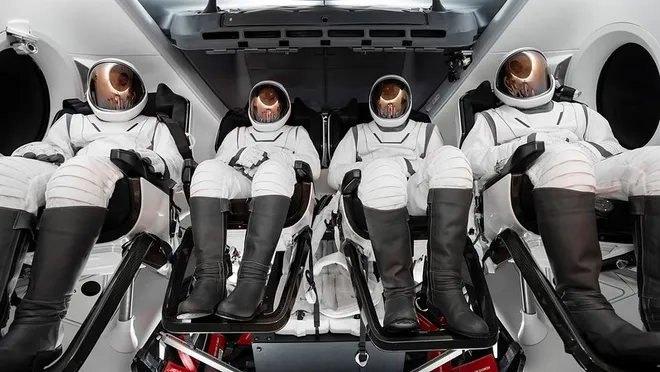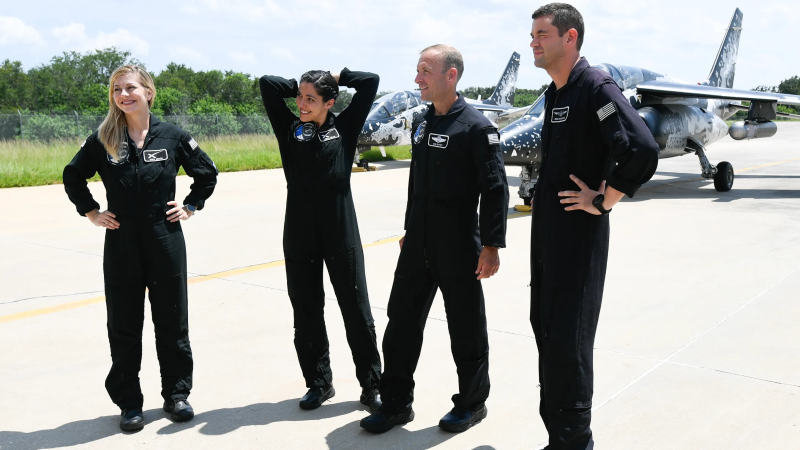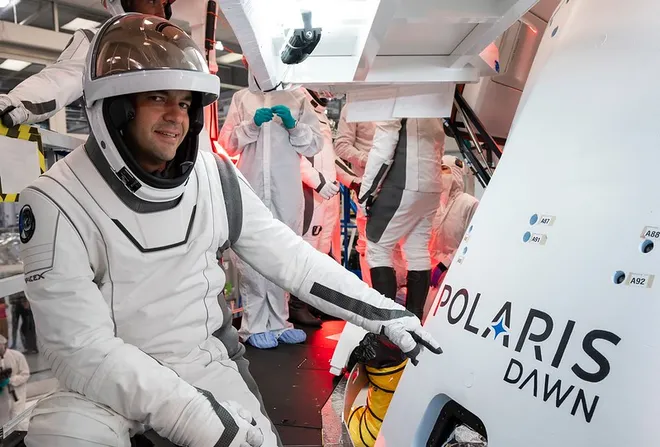Polaris Dawn mission: Launch of commercial crew delayed 24 hours, SpaceX says
- The all-civilian crew hopes to reach heights higher than any astronaut has flown since the Apollo missions of the 1970s.
- When it launches on Falcon 9 rocket, the SpaceX Dragon will ascend to 870 miles above Earth's surface before descending to a cruising orbit about 435 miles above Earth.
- The crew will also attempt to become the first-ever private citizens to conduct a spacewalk, until now a feat that's only been the purview of government astronauts.
The four members of the Polaris Dawn crew will have to wait at least an extra 24 hours before opening a new chapter on commercial space travel.
The SpaceX mission to carry an all-civilian crew to heights higher than any astronaut has reached in decades was initially scheduled for launch early Monday. But now the mission – slated to be the first ever to feature a spacewalk conducted by nongovernment astronauts – won't be happening until Tuesday at the earliest, SpaceX said.
When the SpaceX Dragon carrying the crew does liftoff atop a Falcon 9 rocket, the spacecraft will ascend to 870 miles above Earth's surface before descending to a cruising orbit about 435 miles above Earth. On board the craft will be a pilot and two mission specialists under the command of billionaire entrepreneur Jared Isaacman.
Isaacman, who was also behind Inspiration4 – another historic commercial mission in 2021 that marked the first time an all-civilian crew went to space – helped to fund the mission along with SpaceX. Elon Musk's aerospace company also designed spacesuits specially for the Polaris Dawn crew.
The ambitious spacewalk and the slew of scientific tests Isaacman and his crew intend to make during their five days in orbit could set the stage for future deep space exploration.
Polaris Dawn delayed 24 hours, SpaceX says
News of the 24-hour delay, which SpaceX announced Wednesday on X, came two days after the Polaris Dawn crew arrived at NASA's Kennedy Space Center in Florida to prepare for the imminent launch.
SpaceX said on X, formerly Twitter, that the delay was needed to give teams time to complete preflight checkouts.
SpaceX is now targeting a 3:38 a.m. liftoff Tuesday though the launch window lasts until 7 a.m. If needed, backup launch times are available at the same times on Wednesday.

During the crew's first day in orbit, they will reach altitudes higher than any human has traveled since NASA’s Apollo lunar program came to an end in the 1970s. Climbing to a height of 870 miles above the surface – or more than three times higher than the International Space Station – will take the crew through the treacherous inner regions of Earth's Van Allen radiation belts.
The Van Allen belts pose one of the largest hazards to future spacefarers venturing deep into the cosmos. But for future expeditions to the moon and Mars to be possible, astronauts will have to be able to safely fly through them.
When the Polaris Dawn crew travels through the radiation belts, their SpaceX craft’s nose will be oriented to minimize the astronauts’ exposure to harmful radiation.
The crew will spend five days in orbit testing space technology on behalf of SpaceX that could prove crucial as NASA and other space agencies set their sights on destinations like Mars. On the sixth day of the mission, the SpaceX vehicle will reenter Earth's atmosphere and splash down at one of seven sites off the Florida coast.
Conducting a risky spacewalk

Isaacman, himself an experienced aviator, will serve as mission commander – leading a crew that includes pilot Scott “Kidd” Poteet as well as mission specialists Sarah Gillis and Anna Menon, who is also the medical officer.
Menon, of Houston, plans to read a children's book she co-authored, "Kisses from Space" – inspired by her experience preparing for the Polaris Dawn mission – to her two young children while in orbit.
While in orbit, the crew will complete some 40 scientific experiments – many of which are to understand the human body's reaction to long spaceflights – and test a new laser-based satellite communication system using Starlink.
The crew will also attempt to become the first-ever private citizens to conduct a spacewalk.
Until now, spacewalks have only ever been conducted by government astronauts. And because most spacecraft have airlocks, conducting one does not typically require depressurizing the entire capsule.
But because the Dragon does not have an airlock, the entire spacecraft will have to be depressurized before the hatch is opened, exposing all four crew members to the vacuum of space. For this reason, all four astronauts will be wearing Extra-Vehicular Activity (EVA) suits designed by SpaceX to receive oxygen through tethers.

What's next for the Polaris Program?
Polaris Dawn is the first of three human spaceflights under the Polaris Program, all of which are intended to test SpaceX technologies needed to carry humans deep into the cosmos.

The second mission "will continue to expand the boundaries of future human spaceflight missions, in-space communications, and scientific research," according to the program's website. Additional details, including a launch date, have not yet been announced.
When the day comes that the third and final Polaris Program mission launches, it's intended to be the first human spaceflight on the SpaceX Starship rocket. The gargantuan rocket, which has so far only undergone uncrewed tests, will one day ferry NASA astronauts from lunar orbit to the moon's surface as part of the space agency's Artemis program.
Eric Lagatta covers breaking and trending news for USA TODAY. Reach him at elagatta@gannett.com
Disclaimer: The copyright of this article belongs to the original author. Reposting this article is solely for the purpose of information dissemination and does not constitute any investment advice. If there is any infringement, please contact us immediately. We will make corrections or deletions as necessary. Thank you.




